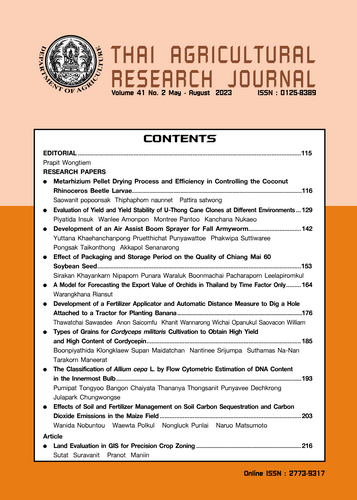Development of an Air Assist Boom Sprayer for Fall Armyworm
DOI:
https://doi.org/10.14456/thaidoa-agres.2023.12Keywords:
air assist boom sprayer, pesticides insecticide, nematodes biocontrol , fall armyworm , cornAbstract
The objective of this research is to address the challenges associated with conventional pest control sprayers, which miss the pest target by over 80% due to the impact of natural wind, resulting in wastage of chemicals, time, and labour. To overcome these challenges, an air assist boom sprayer was developed using the principle of wind to effectively spray liquid ejected into an aerosol of 80-90 micrometers. This was achieved by generating wind power using a shaft-operated gear that drives the fan at speeds of up to 100 km/h, which creates a working width of 6 meters, with 11 nozzles installed at a distance of 50 cm, using a 34-horsepower tractor as the power generator. To determine the density of droplets falling on the target area, paint was sprayed and the density was found to be 80.16 droplets/cm2, with a spray rate of 21.3 rai/hr, an efficiency of 95%, and a fuel consumption of 0.40 l./rai. The effectiveness of the air assist boom sprayer in controlling the fall armyworm was tested in the fields in Tak and Sukhothai provinces in 2020-2021. The prototype was found to be efficient in controlling the fall armyworm and was able to reduce the amount of chemical by 20% when compared to the conventional spraying method that used 60 l./rai of water. Emamectin benzoate 5% SG at the rate of 30 g/ 20 l. water/rai was used for the test. The prototype also demonstrated an increased precision of droplets falling on the target area. Moreover, the prototype can be used to spray the nematodes, a biocontrol agent for fall armyworm effectively, reducing the use rate of nematodes biocontrol product from 300 to 240 million units/rai/time. After 4 nematodes sprays, the damage level of corn leaves did not show significant differences from that of the chemical treatment. The break-even point in using the sprayer is estimated to be 489 rai/year. As a result of these findings, one private sector has already initiated commercial production of the prototype
References
เทคนิคการใช้สารป้องกันศัตรูพืช. 2562. กลุ่มกีฏและสัตววิทยา สำนักวิจัยพัฒนาการอารักขาพืช กรมวิชาการเกษตร. 119 หน้า.
นุชนารถ ตั้งจิตสมคิด. 2563. การเพาะขยายไส้เดือนฝอยสายพันธุ์ไทยเพื่อใช้กำจัดแมลงศัตรูผักแบบทำใช้เอง. เอกสารวิชาการ สำนักวิจัยพัฒนาเทคโนโลยีชีวภาพ, กรมวิชาการเกษตร. พิมพ์ครั้งที่ 3. 38 หน้า.
ยุทธนา เครือหาญชาญพงค์ พักตริ์วิภา สุทธิวารี พฤทธิชาติ ปุญวัฒโท นลินา ไชยสิงห์ และนิรุติ บุญญา. 2562. เครื่องพ่นแบบอุโมงค์ลมสำหรับนาข้าว. รายงานเรื่องเต็ม สถาบันวิจัยเกษตรวิศวกรรม, กรมวิชาการเกษตร. 30 หน้า.
Anonymous. 2023. ASABE standard S572.1 Available at: https://cdn2.hubspot.net/hub/95784/file-32015844-pdf/docs/asabe_s572.1_droplet_size_classification.pdf. Accessed : 15 กุมภาพันธ์ 2566
Darvishvand, M. and R.B. Brown. 1997. Performance of an air assisted forestry boom sprayer. Canadian Agril. Engg. 399 (4): 281-287.
Davis, F.M., and W.P. Williams. 1992. Visual rating scales for screening whorl-stage corn for resistance to fall armyworrm. Mississippi Agricultural & Forestry Experiment Station, Technical Bulletin 186, Mississippi State University, MS39762, USA. 9 p.
Hunt D. 1995. Farm Power and Machinery Management. Iowa State University, Iowa State. United States of America. 220 p.
Lund-Hoie, K. 1985. Efficacy of glyphosate in forest plantation. pp. 328-338. In The Herbicide Glyphosate. E. Grossbard and D.Atkinson. eds. London, Endland: Butterwort & Co.
Nuyttens, D.; S. Windey and B. Sonck. 2004. Optimization of a vertical spray boom for greenhouse spray applications. Biosyst. Eng. 89: 417 - 423.
Planas, S.; F. Solanelles; A. Fillat; P. Walklate; A Miralles; G. Ade; F. Pezzi; L. Andersen and P.G. Ade. 1998. Advances on Air-assisted Spraying on the Mediterranean Orchards (Fruit, Vine and Citrus). EurAgEng Paper Nº 98-A-019. Oslo.
Pojananuwong, S.; D. Wechakit; S. Armeen and A. Chaimanee. 1998. Field efficacy test of low volume application of pesticides against important insect pests and weeds in broadest rice. pp 58-65. In Biennial report, Division of Entomology and Zoology, Department of Agriculture, Bangkok, Thailand.
Taylor, W.A; P.G. Andersen and S. Cooper. 1989. The use of air assistance in a field crop sprayer to reduce drift and modify drop trajectories. pp. 631-639. In Brighton Crop Protection Conference-Weeds. Farnham, Surrey, England: British Crop Protection Council.
Downloads
Published
How to Cite
Issue
Section
License
Copyright (c) 2023 Thai Agricultural Research Journal

This work is licensed under a Creative Commons Attribution-NonCommercial-NoDerivatives 4.0 International License.
Thai Agricultural Research Journal



